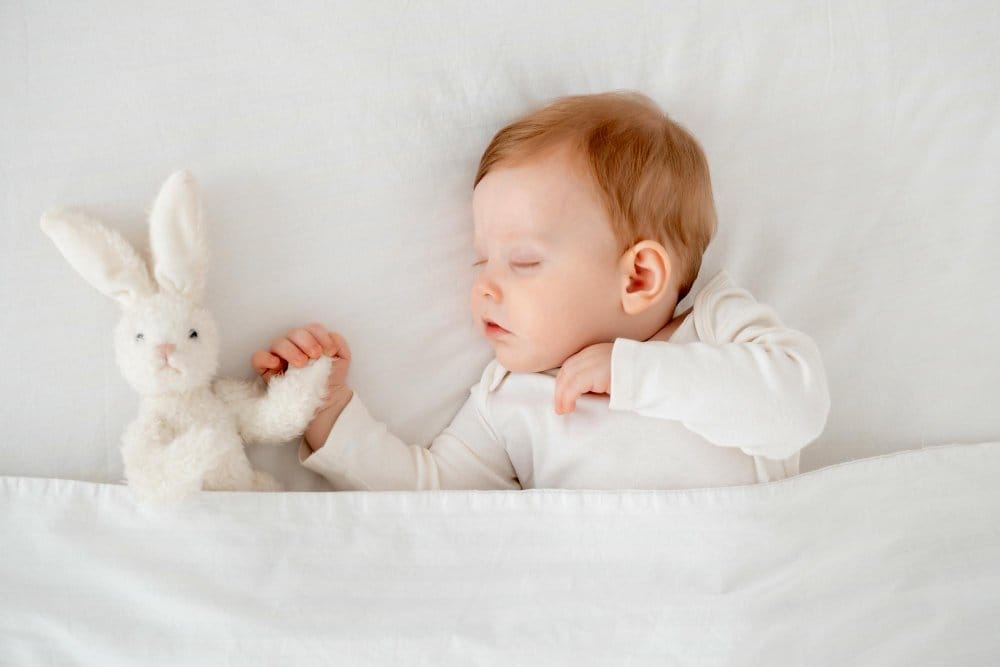A comprehensive guide to safe sleep clothing for newborns based on the latest pediatric recommendations
Table of Contents
- Latest Safe Sleep Guidelines
- Understanding Newborn Sleep Patterns
- Temperature Guidelines and Room Conditions
- Choosing the Right Sleepwear
- Expert Layering Guidelines
- Swaddling Techniques and Safe Alternatives
- Seasonal Dressing Guidelines
- Safe Sleep Accessories and What to Avoid
- Expert-Answered FAQs
- Key Takeaways and Recommendations
Getting your newborn to sleep safely and comfortably starts with choosing the right sleepwear. According to pediatric sleep experts, the proper clothing can make a significant difference in both safety and comfort for your little one. Pediatricians recommend dressing babies in just one more layer than what would make you comfortable in the same room. This simple rule helps prevent overheating while ensuring your baby stays warm enough throughout the night.
Sleep safety goes beyond just clothing choices. Placing your baby on their back to sleep is crucial for reducing the risk of SIDS. Pediatricians recommend using sleep sacks or wearable blankets instead of loose blankets, which can be dangerous for newborns. These specially designed garments keep your baby warm without the suffocation risks that come with traditional bedding.
The clothing you choose should match your home’s temperature and your baby’s needs. In warmer rooms, a simple onesie with a lightweight sleep sack might be perfect. For cooler spaces, layering with a long-sleeved onesie under a sleep sack provides extra warmth. Remember that your baby cannot adjust their own clothing, so it’s up to you to help them stay comfortable all night.
Need Help Choosing the Right Clothing?
Use our baby room temperature calculator to get instant recommendations based on your nursery temperature, or take our seasonal sleep clothing quiz for personalized suggestions.
Latest Safe Sleep Guidelines
Critical Safety Update: Weighted Products Warning
The American Academy of Pediatrics, Consumer Product Safety Commission, and major retailers including Amazon and Target have banned weighted swaddles, sleep sacks, and blankets due to multiple infant deaths. These products are not safe for babies and should never be used for sleep.
The American Academy of Pediatrics updated their safe sleep guidelines in 2022, emphasizing evidence-based recommendations to reduce the risk of SIDS and other sleep-related infant deaths. These guidelines apply to all infants up to 12 months of age.
Essential Safe Sleep Requirements
Safe Sleep Checklist
SIDS Prevention Guidelines
Use a sleep sack or wearable blanket instead of loose blankets. These keep your baby warm without the risk of covering their face during sleep.
Breastfeeding has been linked to reduced SIDS risk, so pediatricians encourage it when possible. Even partial breastfeeding for at least 2 months significantly lowers the risk of sleep-related deaths.
Avoid smoke exposure, which increases SIDS risk. Keep your home and car smoke-free during pregnancy and after birth.
Consider offering a pacifier at sleep time after breastfeeding is established, as this has been associated with lower SIDS risk.
Understanding Newborn Sleep Patterns
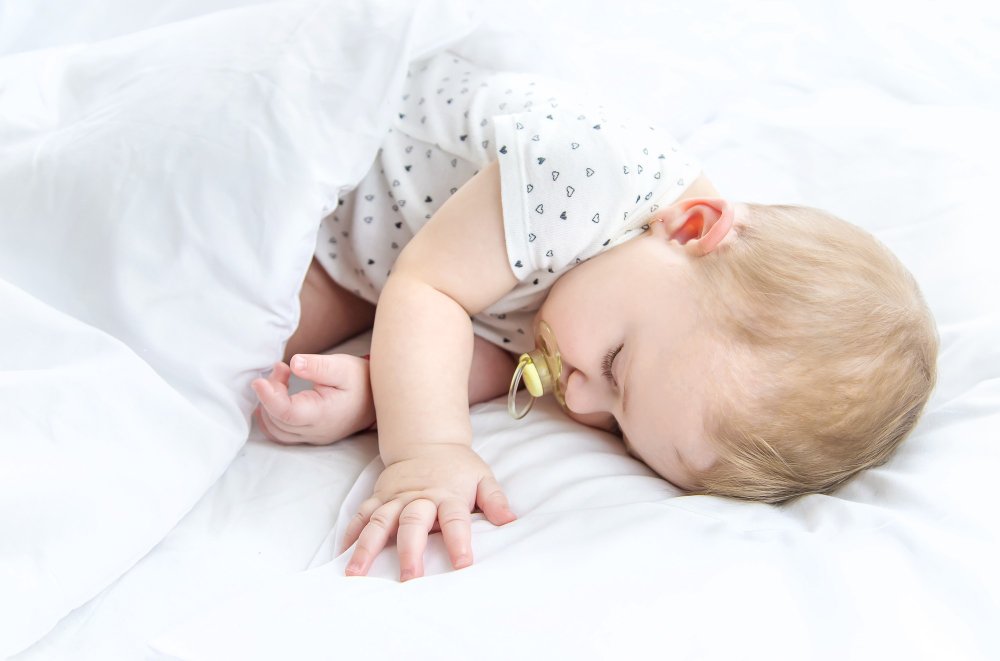
Newborn sleep differs greatly from adult sleep patterns. Babies spend more time in active sleep and cycle through sleep stages more quickly, typically every 50-60 minutes compared to adult 90-minute cycles.
Stages of Newborn Sleep
Newborns have two main sleep states: active sleep and quiet sleep. During active sleep (similar to REM sleep in adults), babies may twitch, grunt, or make sucking movements. Their breathing is irregular, and they process sensory information. This makes up about 50% of newborn sleep.
Quiet sleep is deeper. Your baby will lie still with regular breathing and is harder to wake. As they grow, their sleep patterns will mature, gradually developing more adult-like cycles.
Newborns sleep 14-17 hours daily but only in short stretches of 2-4 hours. This pattern exists because their small stomachs need frequent feeding.
What is the 5 10 15 Rule for Baby Sleep?
The 5-10-15 rule refers to a gentle sleep training method where you allow baby to fuss for 5 minutes the first night, 10 minutes the second night, and 15 minutes the third night before offering comfort. However, this method is not recommended for newborns under 4-6 months old who need immediate attention for feeding and comfort.
Building Healthy Sleep Routines
Even though newborns don’t follow day-night schedules initially, establishing a simple routine early helps them develop healthy sleep habits. A consistent bedtime routine signals to your baby that sleep time is approaching.
Pediatric sleep consultants recommend starting with basic steps like dimming lights, changing into sleep clothes, and gentle rocking or singing. Keep the routine short, about 15-30 minutes, and consistent each night.
Routines help regulate your baby’s internal clock and create sleep associations that become increasingly important as they grow. During daytime naps, keep the routine lighter to help babies learn the difference between day and night sleep.
Temperature Guidelines and Room Conditions
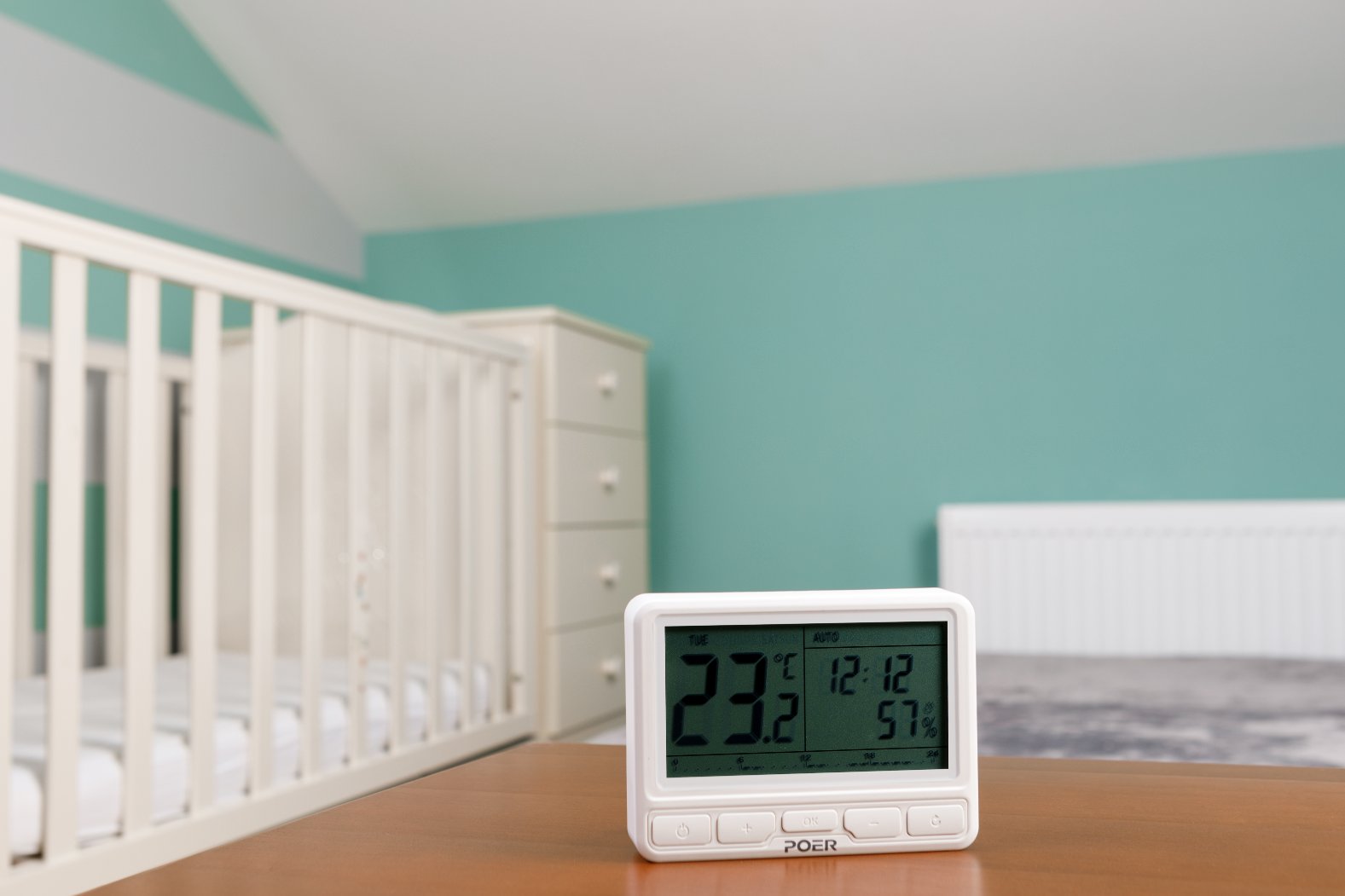
Creating the right sleep environment helps your newborn rest safely and comfortably. The room’s temperature and overall setup directly impact your baby’s sleep quality and safety.
Optimal Room Temperature
The ideal temperature for a newborn’s sleep space is between 68-72°F (20-22°C). This range prevents overheating, which research has linked to increased SIDS risk. Pediatricians recommend using a reliable room thermometer to monitor conditions.
| Room Temperature | Recommended Clothing | Sleep Sack TOG |
|---|---|---|
| Above 75°F (24°C) | Diaper + light onesie or just diaper | 0.5 TOG or none |
| 72-75°F (22-24°C) | Short-sleeve onesie | 0.5-1.0 TOG |
| 68-71°F (20-22°C) | Long-sleeve onesie | 1.0-2.0 TOG |
| 65-67°F (18-19°C) | Long-sleeve onesie + footed pajamas | 2.5 TOG |
| Below 65°F (18°C) | Multiple layers + footed pajamas | 3.0+ TOG |
How to Tell if a Newborn is Cold at Night
Check your baby’s chest, neck, or back of the neck, these areas should feel warm but not hot. Cold hands and feet are normal for newborns due to poor circulation and are not reliable indicators of overall body temperature. Signs your baby may be cold include:
- Cool chest or tummy when touched
- Pale or mottled skin
- Fussiness or difficulty settling
- Crying that’s different from their normal cry
How to Tell if a Newborn is Too Hot
Overheating is more dangerous than being slightly cool. Signs of overheating include:
- Sweating, especially on the neck or back of head
- Flushed or red cheeks
- Rapid breathing or panting
- Heat rash on chest or neck
- Restlessness or difficulty staying asleep
- Hot, clammy skin
Creating the Ideal Sleep Environment
Avoid placing the crib near heaters, air conditioners, or drafty windows. These can create temperature fluctuations that disrupt your baby’s sleep and comfort.
The sleeping area should be simple and free of suffocation hazards. Pediatric sleep experts recommend using a firm mattress with a fitted sheet only, no pillows, blankets, or toys in the crib.
Room-sharing (not bed-sharing) is recommended for the first 6-12 months. Place the crib or bassinet near your bed for convenient nighttime care while maintaining a separate sleep space.
What is the 60 Minute Crib Rule?
The 60-minute crib rule suggests that if your baby falls asleep in a car seat, swing, or other sitting device, they should be moved to a safe sleep surface (crib or bassinet) within 60 minutes. Prolonged sleep in sitting devices can restrict breathing and is not recommended for routine sleep.
Choosing the Right Sleepwear
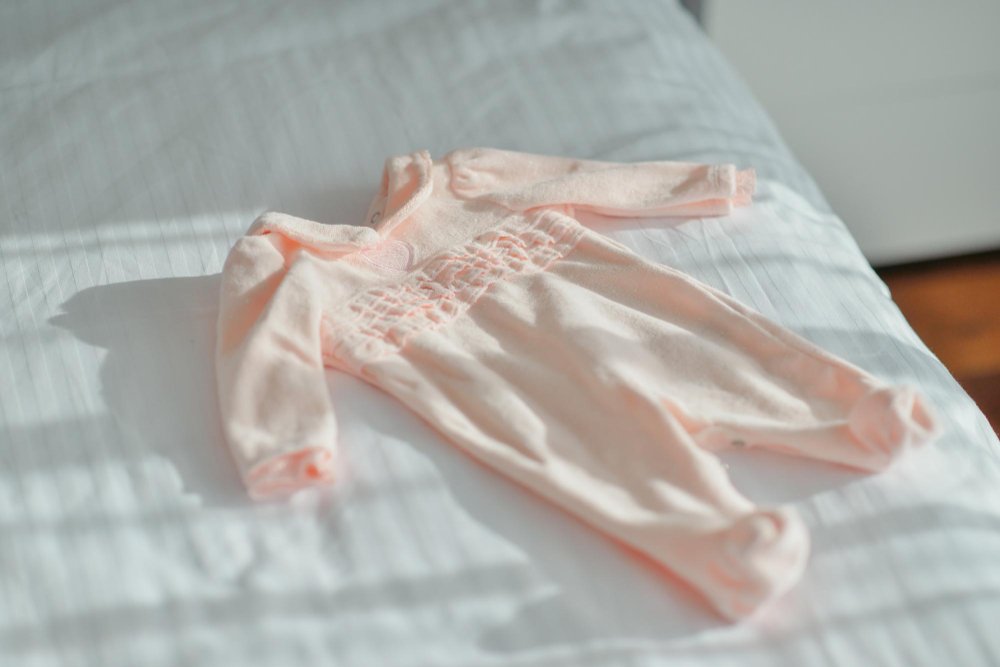
Selecting appropriate sleepwear for your newborn is crucial for their comfort and safety during sleep. The right fabric and warmth level can help your baby stay comfortable throughout the night without overheating.
Safe Fabric Choices
Pediatricians recommend focusing on breathable fabrics for your baby’s sleepwear. Cotton is an excellent choice because it’s soft, gentle on sensitive skin, and allows air circulation. Muslin is another great option, especially for warmer weather, as it’s lightweight and highly breathable.
Avoid synthetic materials that might trap heat. Instead, look for organic cotton or bamboo blends that wick moisture away from your baby’s skin.
For cooler nights, microfleece sleep sacks offer warmth without bulk. They’re soft against the skin while providing good insulation.
Always check labels for flame-retardant chemicals. While safety is important, some babies have sensitivities to these treatments. Look for non-toxic alternatives when possible.
Understanding TOG Ratings
TOG (Thermal Overall Grade) ratings indicate how warm a sleep garment is. The higher the TOG, the warmer the garment. This system helps you choose appropriate sleepwear based on room temperature.
Very Light
For rooms above 75°F (24°C)
Summer weight, very breathable
Light
For rooms 68-75°F (20-24°C)
Standard room temperature
Medium
For rooms 61-68°F (16-20°C)
Cooler environments
Warm
For rooms below 61°F (16°C)
Winter weight
Sleep experts always recommend checking your baby’s neck or chest, if it feels sweaty, they’re too warm. If their hands feel cool but not cold, they’re properly dressed.
Remember that overdressing poses a greater risk than underdressing. It’s better for baby to be slightly cool than overheated.
Find Your Perfect TOG Rating
Not sure which TOG rating to choose? Our TOG rating selector tool helps you pick the ideal sleep sack warmth based on your baby’s age, season, and room temperature.
Types of Safe Sleepwear
Onesies: The foundation of newborn sleepwear. Choose short or long-sleeved options based on temperature.
Footed Sleepers: All-in-one garments that keep feet warm. Great for cooler weather but avoid in hot conditions.
Sleep Sacks: Wearable blankets that replace loose bedding. Available in various TOG ratings for different temperatures.
Baby Gowns: Open-bottom garments that make diaper changes easier while providing warmth.
Can a Baby Sleep in Just a Onesie?
Yes, in warm weather (above 75°F/24°C), a baby can safely sleep in just a onesie or even just a diaper. This prevents overheating while keeping them comfortable. Always check the room temperature and your baby’s body temperature to ensure they’re not too warm or cold.
Expert Layering Guidelines
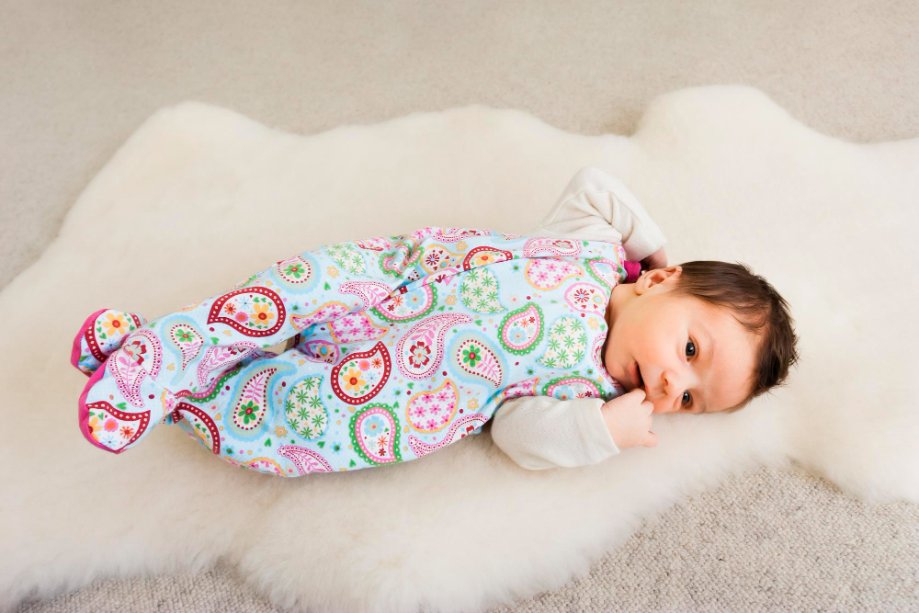
Dressing your newborn appropriately for sleep is essential for their safety and comfort. Proper layering helps maintain your baby’s temperature throughout the night without overheating or chilling them.
The Plus-One Rule
Pediatricians recommend following the simple “+1 rule” when dressing your newborn for sleep. This means your baby should wear one more layer than what you would find comfortable in the same environment. For example, if you’re wearing a t-shirt and sweatpants, your baby might need a onesie plus a sleep sack.
Room temperature plays a crucial role in determining layers. The ideal sleep environment is between 68-72°F. In this range, a baby typically needs:
| Room Temperature | Base Layer | Outer Layer |
|---|---|---|
| Warm room (71-72°F) | Short-sleeve onesie | Light sleep sack (0.5-1.0 TOG) |
| Moderate room (69-70°F) | Long-sleeve onesie | Standard sleep sack (1.0-2.0 TOG) |
| Cooler room (68°F) | Long-sleeve onesie | Warmer sleep sack (2.5 TOG) |
Watch for signs of temperature discomfort like sweaty neck, flushed cheeks (too hot) or cool chest, mottled skin (too cold).
For personalized layering recommendations based on your specific situation, try our seasonal baby sleep clothing quiz which considers your climate, baby’s age, and preferences.
Selecting Appropriate Layer Types
The base layer should be breathable and comfortable against your baby’s skin. Pediatricians recommend cotton onesies that fit properly without being too loose or restrictive.
For the outer layer, choose between:
Swaddles: Best for newborns up to 2-4 months who aren’t rolling yet. Swaddles help mimic the womb environment and reduce startle reflexes that can wake babies.
Sleep sacks: Safer once baby begins rolling (typically 2-4 months). They come in different TOG ratings:
- 0.5 TOG: Lightweight for warm rooms
- 1.0 TOG: Medium weight for standard temperatures
- 2.5 TOG: Heavier for cooler environments
Avoid loose blankets, hats, or excessive layers that could increase the risk of overheating or pose suffocation hazards during sleep.
What Should a Newborn Wear to Sleep?
A newborn should wear a fitted onesie (short or long-sleeved depending on room temperature) with a sleep sack or swaddle. In very warm conditions (above 75°F), just a onesie or even a diaper may be sufficient. Never use loose blankets, hats, or weighted items.
Swaddling Techniques and Safe Alternatives
Swaddling helps many newborns feel secure and sleep better, but it’s important to do it correctly. Some babies don’t enjoy being swaddled, and all babies eventually need to transition to other sleep options.
How to Swaddle Safely
To swaddle safely, start with a lightweight muslin swaddle blanket on a flat surface. Fold one corner down and place your baby on top with their shoulders just below the fold. Keep their arms straight at their sides. Wrap one side of the blanket across their body and tuck it underneath them.
Then bring the bottom corner up over their feet, leaving room for hip movement. Babies’ hips need space to develop properly. The swaddle should be snug but not tight.
Always place swaddled babies on their backs to sleep. Never place them on their sides or stomachs, as this increases the risk of SIDS.
Check that the swaddle isn’t covering your baby’s face or neck. Pediatricians recommend watching for signs of overheating like sweating or flushed cheeks.
When to Transition Out of Swaddling
You must stop swaddling as soon as your baby shows signs of rolling over, typically around 2-4 months. This is a critical safety rule because a swaddled baby who rolls onto their stomach faces increased suffocation risk.
Some babies signal they’re ready earlier by constantly fighting the swaddle or seeming uncomfortable. Watch for these cues from your little one.
When transitioning, you have several good options. Sleep sacks provide warmth without restricting movement. Some transition products keep arms free while maintaining the snug feeling around the torso.
Try transitioning one arm out of the swaddle for a few nights before removing both arms. This gradual approach often works well for babies who rely on swaddling for sleep.
Seasonal Dressing Guidelines
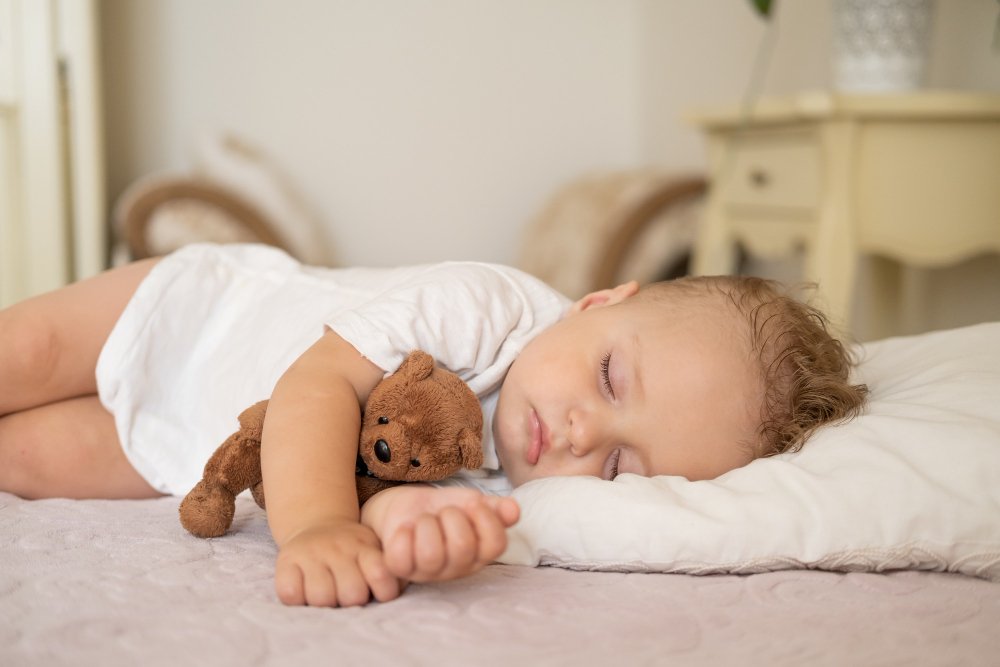
Summer Sleep Guidelines
During hot weather, preventing overheating is the primary concern. For rooms above 75°F (24°C), your baby may need only a diaper or a very lightweight onesie.
Key summer guidelines:
- Use breathable cotton or muslin fabrics
- Consider a 0.5 TOG sleep sack or no sleep sack at all
- Ensure good air circulation with a fan (not directed at baby)
- Monitor for signs of overheating more frequently
Need help choosing summer sleepwear? Our temperature calculator provides specific recommendations for hot weather conditions.
What to Dress a Newborn in for Sleep in the UK?
In the UK’s variable climate, layering is key. Use a long-sleeved onesie with a 1.0-2.0 TOG sleep sack for most conditions. During warmer summer days, reduce to a short-sleeved onesie with a 0.5 TOG sleep sack. Always check room temperature as UK homes often lack air conditioning.
Winter Sleep Guidelines
Layer clothing appropriately during winter. Start with a onesie, add footed pajamas if needed, and use a warm sleep sack or swaddle.
Keep the room temperature between 68-72°F (20-22°C). Avoid overheating the room, as this can increase SIDS risk.
Never use loose blankets, hats, or gloves during sleep as these pose suffocation hazards. A properly fitting sleep sack provides warmth without these risks.
Winter safety considerations:
- Use appropriate winter fabrics like microfleece for sleep sacks
- Layer with footed pajamas over onesies
- Choose 2.5-3.0 TOG sleep sacks for very cold rooms
- Monitor for both overheating and being too cold
Get personalized winter sleepwear recommendations by taking our seasonal clothing quiz which factors in your climate and heating situation.
Do Babies’ Feet Need to be Covered at Night?
Babies’ feet do not need to be covered at night unless the room is particularly cold. Footed pajamas or sleep sacks are sufficient. Separate socks or booties can slip off and become a suffocation hazard. Cool feet are normal for newborns due to immature circulation.
What Age Can a Baby Have a Duvet?
Babies should not use duvets, pillows, or loose bedding until at least 12 months old, and preferably not until 18-24 months when they can move freely and understand how to remove items from their face. Until then, use sleep sacks or wearable blankets for warmth.
Safe Sleep Accessories and What to Avoid
When dressing your newborn for sleep, you need to be thoughtful about accessories. The right choices keep your baby safe while helping them sleep comfortably.
Head Coverings and Hats
Head coverings are generally not recommended for babies during sleep. Hats, bonnets, and other head accessories can increase the risk of overheating and potentially lead to SIDS.
Why Do Hospitals Put Hats on Newborns?
Hospitals put hats on newborns only in the first few hours of life when babies are learning to regulate their temperature, or in the NICU for medical reasons. Once your baby comes home, hats should not be worn indoors or during sleep as they can cause overheating and pose a suffocation risk.
Pediatric sleep experts recommend removing all head coverings before placing your baby down to sleep. This allows proper temperature regulation through their head, which is an important cooling mechanism for infants.
If your home is particularly cold, it’s better to adjust the room temperature or use appropriate sleep clothing rather than putting a hat on your baby.
For outdoor naps, you might need weather-appropriate head protection, but always remove it once you’re inside or when your baby is sleeping in their regular sleep space.
What to Avoid in the Sleep Environment
For newborns and young infants, pediatricians strongly advise against having any loose items in the sleep area, including comfort items like stuffed animals, blankets, or pillows.
The American Academy of Pediatrics recommends a bare crib with just a fitted sheet. Comfort items pose suffocation and strangulation hazards for babies who can’t yet move themselves away from obstacles.
Products to Never Use for Infant Sleep
- Weighted swaddles, sleep sacks, or blankets
- Loose blankets or pillows
- Crib bumpers
- Positioning devices
- Inclined sleep products (over 10 degrees)
- In-bed sleepers that don’t meet federal safety standards
- Hats or head coverings during sleep
- Loose socks or booties that can slip off
As your baby grows older (typically after 12 months), you might introduce a small comfort item like a lovey or security blanket, but only under supervision.
If you’re concerned about your baby’s comfort, consider a wearable blanket or sleep sack instead. These provide the coziness of a blanket without the safety risks of loose bedding.
Expert-Answered Frequently Asked Questions
For cooler rooms (65-68°F/18-20°C), pediatricians recommend dressing your newborn in a long-sleeve onesie, footed pajamas, and a sleep sack or swaddle.
In moderate temperatures (69-72°F/20-22°C), a long-sleeve onesie with a sleep sack or lightweight swaddle works well.
For warmer rooms (73-75°F/23-24°C), a short-sleeve onesie and light swaddle is sufficient. Above 75°F/24°C, a diaper and thin cotton swaddle may be all your baby needs.
In a 72°F room, dress your newborn in a lightweight long-sleeve onesie and a thin cotton sleep sack with a 1.0 TOG rating. This provides enough warmth without overheating.
If your baby seems comfortable, this combination should work well. Some babies run warmer than others, so you may need to adjust based on how your baby responds.
Always check your baby’s neck or tummy to confirm they’re at a comfortable temperature.
Layer clothing appropriately during winter. Start with a onesie, add footed pajamas, and use a warm sleep sack or swaddle with a 2.5-3.0 TOG rating.
Keep the room temperature between 68-72°F (20-22°C). Avoid overheating the room, as this can increase SIDS risk.
Never use loose blankets, hats, or gloves during sleep as these pose suffocation hazards. A properly fitting sleep sack provides warmth without these risks.
Check your baby’s neck, chest, or upper back, it should feel warm but not sweaty. Cold hands and feet don’t necessarily mean your baby is cold, as newborns have poor circulation.
Signs of overheating include: sweating, flushed cheeks, rapid breathing, heat rash, or restlessness. If your baby seems too warm, remove a layer of clothing.
Signs of being too cold include: cool chest and tummy, pale or blotchy skin, and fussiness. Add a layer if your baby seems cold, but never use loose blankets.
Swaddles are ideal for newborns until they start rolling over (around 2-4 months). They mimic the womb environment and reduce startle reflexes that can wake babies.
Sleep sacks are safer once babies begin rolling. They allow arm movement while keeping them warm without loose bedding.
When using a swaddle, dress your baby in one less layer than you would with a sleep sack. The tight wrap of a swaddle adds warmth, so adjust clothing accordingly.
Feel your baby’s chest, neck, or back, these should be warm to the touch. If these core areas feel cool, your baby may need an additional layer.
Other signs include: restless sleep, frequent waking, fussiness, pale skin, or crying that’s different from their usual patterns.
Remember: cool hands and feet are normal due to poor circulation and don’t indicate your baby is cold overall.
Key Takeaways and Recommendations
Essential Safety Guidelines
- Follow the +1 rule: Dress your baby in one more layer than you’d wear in the same room to balance warmth and safety
- Always place babies on their backs to sleep and use sleep sacks instead of loose blankets
- Never use weighted products: Weighted swaddles, sleep sacks, and blankets are unsafe and have been linked to infant deaths
- Monitor room temperature: Maintain 68-72°F and adjust baby’s sleepwear accordingly for ideal sleeping conditions
- Remove head coverings: Hats and bonnets should not be worn during sleep to prevent overheating
Expert Recommendations for Safe Sleep
Creating a safe sleep environment for your newborn requires attention to both clothing choices and overall sleep setup. Based on the latest American Academy of Pediatrics guidelines and pediatric sleep expert recommendations, the most important factors are proper temperature regulation, safe sleepwear choices, and adherence to evidence-based safety practices.
Temperature management is crucial for newborn safety and comfort. The ideal room temperature of 68-72°F, combined with appropriate clothing layers, helps prevent both overheating and chilling. Remember that overheating poses a greater risk than being slightly cool, so when in doubt, err on the side of fewer layers.
The transition from swaddling to sleep sacks around 2-4 months is a critical safety milestone. Watch for signs of rolling and make this transition promptly to prevent suffocation risks. Quality sleep fabrics and proper TOG ratings ensure your baby stays comfortable throughout developmental changes.
Building Healthy Sleep Habits
Establishing consistent sleep routines early helps your baby develop healthy sleep patterns. This includes not only appropriate sleepwear but also consistent bedtime practices that signal sleep time. Proper care of sleep garments ensures they remain safe and comfortable for repeated use.
As your baby grows, their sleep needs and safety requirements will evolve. Stay informed about current recommendations, as guidelines are regularly updated based on new research. The investment in proper sleepwear and safe sleep practices provides both immediate safety benefits and supports long-term healthy sleep development.
Quick Tools to Help You
Make choosing the right sleep clothing easier with our interactive tools:
- Room Temperature Calculator – Get instant clothing recommendations
- TOG Rating Selector – Find the perfect sleep sack warmth
- Seasonal Clothing Quiz – Personalized recommendations for your situation
When to Seek Professional Guidance
Consult your pediatrician if you have concerns about your baby’s sleep patterns, temperature regulation, or if you notice any signs of sleep-related difficulties. Professional guidance is especially important for premature babies or those with special health considerations.
If your baby consistently seems uncomfortable despite following these guidelines, or if you’re unsure about appropriate clothing choices for your specific climate or living situation, don’t hesitate to seek advice from certified pediatric sleep consultants or your healthcare provider.
Safe sleep practices are one of the most important gifts you can give your newborn. By following these expert-backed guidelines for sleep clothing and environment, you’re providing your baby with the foundation for healthy, safe sleep that will benefit them throughout their development.

